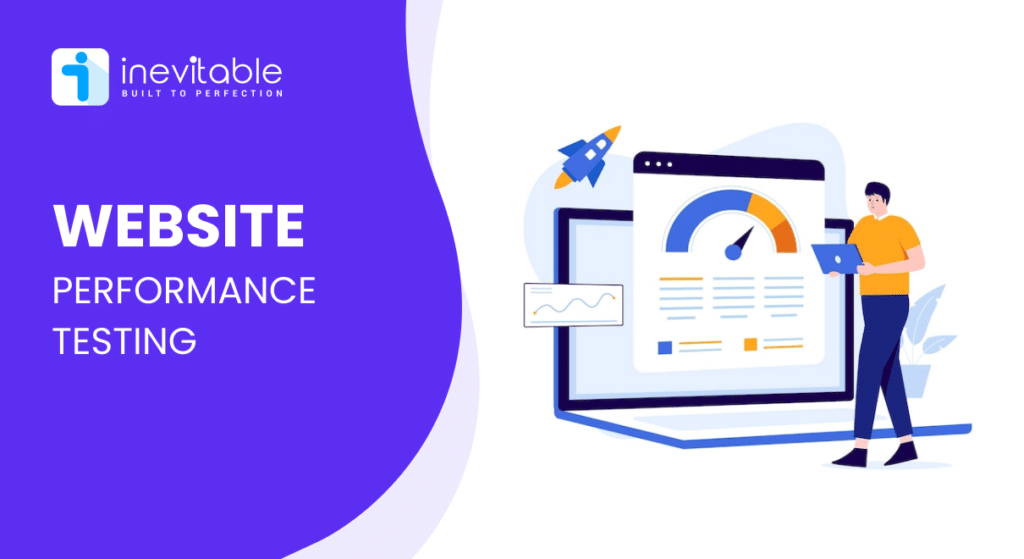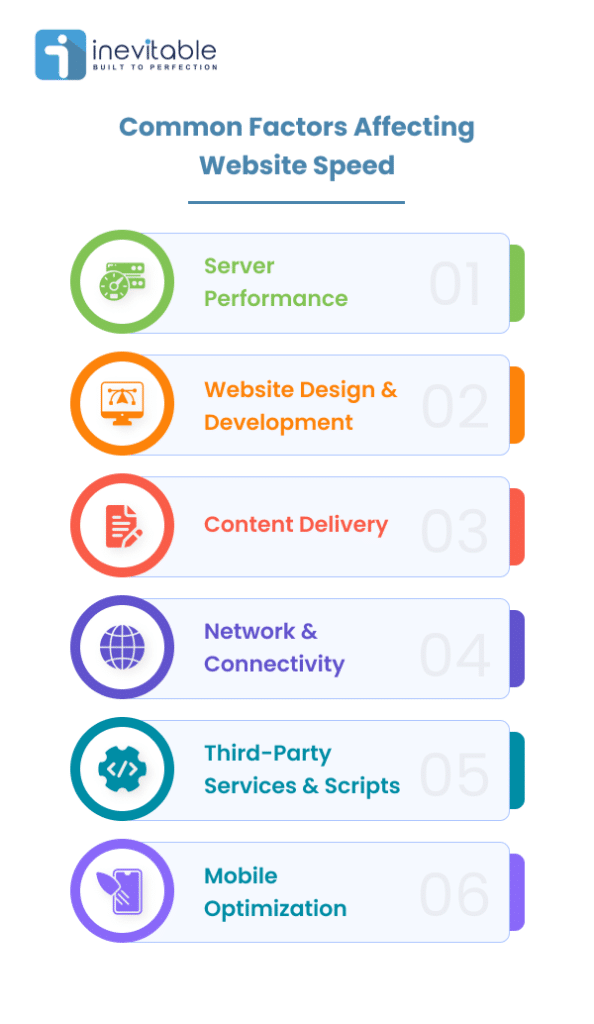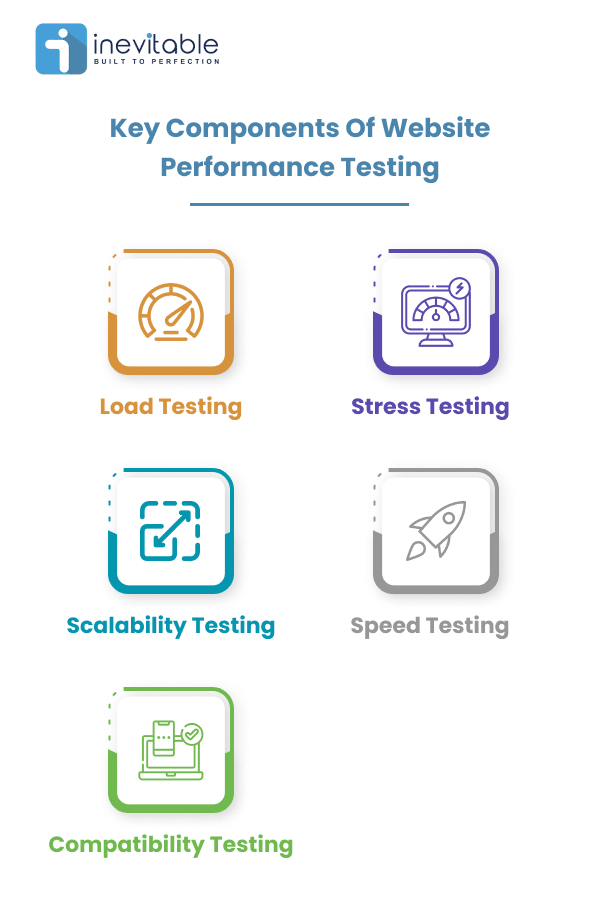Contents
- Introduction
- What Is Website Performance Testing?
- Impact of Poor Website Performance
- Understanding the Benefits of Website Performance Testing
- Common Factors Affecting Website Speed
- Key Components of Website Performance Testing
- Implementing an Effective Website Performance Testing Strategy
- Some Common Misconceptions About Website Performance Testing
- Conclusion (Implementing Performance Testing in Your Business)

Introduction
Website performance testing refers to the practice of assessing the speed, responsiveness, throughput, scalability, and other aspects of a website application. It is done to test the performance of a website to improve end-user experience. According to a study made by Forbes, around 40% of online users leave a website if it takes more than 3 seconds to load. It is an important indicator of the fact that:
- The website’s performance is a key performance indicator for a business’s success
- Having a website with good speed, and responsiveness can cause excellent engagement and user satisfaction
- If a website is not user friendly around 88% of online users will not return to the page
Therefore we can understand how important website performance testing is, to maintain a healthy running business.
What Is Website Performance Testing?
Website performance testing is a type of non-functional testing that is done to check the responsiveness, scalability, and throughput of a website under test, to improve the end-user experience. Several kinds of tests are involved in website performance testing. They are load testing, stress testing, endurance testing, and more.
Impact of Poor Website Performance
Poor performance of a website can have a tremendous amount of negative impact on any business online or offline. These impacts may include a significant amount of reduction or loss in revenue generation, loss of traffic, lower rate of user engagement, and drop in conversion rate.
Apart from end-user experience, bad performance of websites can also lead to a drop in the Google ranking, making it difficult for the users to find it, let alone engage with it. According to statistics by Forbes, a low-performing website can lose up to $2.6 annually, owing to just a low loading speed. To help you understand the impact of poor website performance we are going to elaborate on each of the crucial factors in more detail:
1. Loss of Potential Customers
Loss of customers, whether they are potential or repeat ones, is a major loss to any business. Especially if somebody is landing on a website for the first time and finds it takes a long time to load, respond, or solve its query, the chances of that customer leaving the website immediately. Another study shows that when a customer goes through a negative experience there is a 44% chance that they would share a negative impression about that website with their friends online. That leads to the next concern: Negative Brand Image and Reputation.
2. Negative Brand Image and Reputation
Negative Brand Image and Reputation a serious hurdles in making a brand succeed. Once the brand reputation is marred, it is very difficult to regain the trust and the loyalty of customers. In fact, according to a study made by Marketing News Canada, 94% of consumers decide not to engage with a brand if they have gone through any negative reviews about it online. So it is the hard truth that any negative review about your website or its functionality can lead to a loss of a majority of potential customers for your business.
3. Decreased Conversion Rates
Lastly, bad website performance is the major reason why there is a decrease in the conversion rate of a business. Conversion rate is the most important factor that determines the growth of a business. The scalability of a website, its smooth functioning, and its less complicated page path, all of these factors are responsible altogether for ensuring that a user is converted and revenue is generated.
According to a recent study, B2B websites with a page load speed of 1 second or less usually have 3x times higher conversion rates than other websites. The opposite is also deemed true when we say that a website that takes more than 5 seconds to load, will automatically lose its customers and revenue.
Understanding the Benefits of Website Performance Testing
To avoid the problems mentioned above a lot of businesses these days are opting for website performance testing. Website performance testing is directly responsible for improving end-user experience. Fast-loading Webpages with smooth web design, and useful content with meaningful CTAs, all of these factors can help improve user engagement, satisfaction, and retention.
Other than that, it is also responsible for improving the search engine ranking of the website. What website performance testing allows is that it identifies bottlenecks beforehand to make sure that the site functions efficiently under various conditions. Website Performance Testing helps reduce the bounce rate of a page resulting in the prevention of revenue loss. To help you understand the importance of Performance testing better, let us throw light on each of the factors in more detail:
1. Enhancing User Experience (UX)
Web Performance Testing is crucial when it comes to enhancing the end-user experience. This type of testing ensures that the website operates smoothly, quickly, and efficiently, without any unwanted crashing or delays. It helps the website perform as per the user expectations: fast with responsive web interactions. To avoid slow-loading pages (which only creates frustration among the users and increases bounce rate) performance testing of websites is considered to be extremely important.
2. Improving Search Engine Rankings
Search Engine Ranking is a crucial factor that determines whether your business will stand out from your competitors or not. Just by being on the first page of the Google search engine, businesses can attract huge amounts of traffic and increase their chance of conversion. But at the same time, according to a study made by Forbes, 38% of users won’t engage with a website if it is poorly designed. This inevitably implies that if a website offers poor layout or functionality, user engagement drops drastically. And if the engagement drops that then affects the search engine ranking of a website.
3. Boosting Customer Engagement and Retention
Finally, the benefit of website performance testing is boosting the customer engagement and retention rate of your website. Another statistic by Forbes shows that 43% of small businesses invest in their website performance. The reason is that these small businesses want to increase their online presence by providing well-optimized and well-designed websites that satisfy user expectations.
Common Factors Affecting Website Speed

Several factors affect the speed of a website. These factors are Server Performance, Website Design and Development, Content Delivery, Network and Connectivity, Third-Party Services and Scripts, Mobile Optimization, etc.
Your website’s Server Performance is directly responsible for page load time and response time. A slow processing server will make your website slower with high latency, or insufficient resources. Website Design and Development includes a lot of factors like page size, large images, or simply inefficient code that can slow down a page. Content Delivery is yet another important factor to consider here. If website resources are not being delivered to the users then Content Delivery Networks (CDNs) and server locations need to be optimized to improve user experience.
Other factors like Network and Connectivity also play a major role in affecting the speed of a website. Network and connectivity are important to get data transmission done between the website and the user. If there is network congestion then the website gets slower. Additionally, if there are any additional dependencies or external requests like some third-party service or script, then that is also responsible for slowing down the website speed and overall performance.
Key Components of Website Performance Testing
There are several key components of Web Performance Testing such as Load Testing, Stress Testing, Scalability Testing, Speed Testing, and Compatibility Testing. Let us discuss each one of these components in further detail below:

1. Load Testing
Load testing in website performance testing is very similar to load testing of software. In Website Performance Testing, load testing refers to the amount of user interaction that a website can handle during its typical and peak traffic scenario. In this process, the tester is responsible for simulating a large number of user requests and interactions accessing the website simultaneously. Under these conditions, the performance of the website, its behavior, its maximum operating capacity, etc. is discovered. In this process, bottlenecks and limitations of the website are also identified. It ultimately contributes to highlighting the areas that need improvement to offer a seamless user experience.
2. Stress Testing
Stress testing in website performance testing refers to the practice of assessing website behavior under extreme load conditions. In this type of testing the tester is responsible for generating load conditions that go beyond its normal operational capacity. In this type of website performance testing service, the threshold or the breaking point of a website is determined. It is a crucial part of website performance testing as it uncovers the truth about the website’s reliability and robustness.
3. Scalability Testing
In web performance testing, scalability testing refers to the evaluation of a website based on its capacity to efficiently scale up during a situation of increased workload or user traffic. It is done to test whether the website is capable of handling a large number of user requests, transactions, data transfers, and more as the typical traffic keeps growing over time. In this kind of testing, the tester is usually responsible for identifying the maximum capacity of the current infrastructure and identifying the point from where the functionality of the website starts to degrade.
4. Speed Testing
One of the most important aspects of website performance testing is to test its speed. The process of speed testing for a website involves testing the time that the website takes to load and become responsive for the users. In this type of testing, the tester is responsible for checking the website’s page load speed and server response time, across platforms and devices. It is another crucial aspect of web performance testing as it identifies the various factors that slow down a website’s performance (the aspects that are discussed above).
5. Compatibility Testing
Compatibility of website and software applications refers to the evaluation of the said project across various devices, platforms, and operating systems. Statistically speaking, 73% of users tend to return to a website that is mobile-friendly. It refers to the fact that if your website is only desktop friendly it is not enough. You must ensure that the mobile version of your website is also smooth, and easy to use for the end-users.
Implementing an Effective Website Performance Testing Strategy
Now, performing website performance testing without implementing an efficient strategy may fail the whole purpose of the test. This is the reason why, it is advised to always construct a well-structured strategy, before starting to test the performance of the website. To help you with it, here are a few steps that you can follow to ensure you come up with a foolproof plan before starting the performance testing:
Step 1: Setting Clear Performance Goals
As mentioned before, website performance testing can be complicated in many ways as it focuses on several aspects like page load speed, server performance, website design, content delivery, and more. Before you start, make sure your goal is clear. If several aspects are required to be tested then the performance testing strategy must include the most urgent feature to be tested first and then move on to the less important ones. However, when you approach the testing procedure, make sure you have set performance goals before starting the process abruptly.
Step 2: Choosing the Right Testing Tools and Technologies
The next step is to choose the right performance testing tools for your testing. There are several website performance testing tools available like LoadRunner, Apache JMeter, WebLOAD, NeoLoad, and more. Choose the right tool that is suitable for your set goals.
Step 3: Establishing Baseline Metrics for Performance Evaluation
As the third and final step, you must select the key performing metrics for performance evaluation. These metrics include load time, response time, throughput, scalability, server CPU utilization, error rate, resource leaks, and more. Each of these metrics signifies key performance areas that are required to be tested to check for bottlenecks and lag times.
Some Common Misconceptions About Website Performance Testing
When it comes to website performance testing, there are certain misconceptions in the industry. One of the misconceptions is that it is important only for large-scale websites. Another misconception that lies in the industry is that website performance testing is a one-time task. Finally, it is believed in the industry that performance testing of the website is something that is only the concern of the technical team. Let us bust these misconceptions and reveal the truth to you:
- Website performance testing is crucial for all kinds of websites, big or small. Whether it is a small start-up or a large-scale business, every website needs to be optimized and updated according to its functionality. It improves user experience and directly impacts the traffic and revenue of the said business.
- Website performance testing should done now and then. As the traffic keeps growing, the website must be tested for its reliability, security, speed, and scalability. And especially before the advent of big sales or events that can generate higher traffic than usual.
- Website performance testing is a concern for everyone in the company. It is true, that not just the technical team, but everyone involved in the company must keep a check on the website functionality and opt for performance testing whenever seems necessary.
Conclusion (Implementing Performance Testing in Your Business)
So make sure you implement performance testing in your business to ensure steady growth of your traffic and revenue. There are several website performance testing service providers that you can connect with to get your website optimized. If not sure where to look you can connect with our performance testers to get your website checked. Check out our performance test services here and get in touch today!


